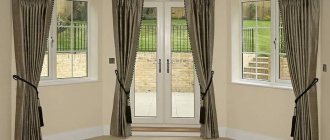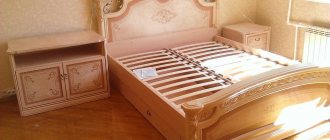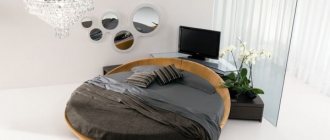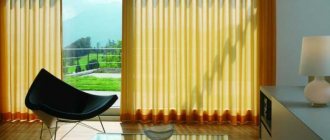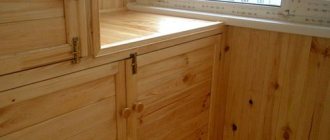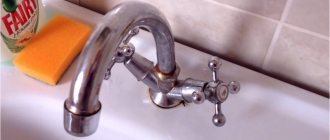There are many ways to hang curtains. These can be stick-type cornices, no cornice at all, or aluminum cornices.
But recently, almost the most common cornices are... Ceiling. But not everyone knows how to hang even the simplest curtains correctly.
I even came across a situation where the curtains were hung on threads near the braid, or were hung almost crawling along the ceiling.
Hanging curtains on a ceiling cornice is much easier than it sometimes seems to non-professionals.
And to explain how to hang curtains on a ceiling cornice, I made a short training video especially for you, in which you will learn about the simplest and least energy-consuming way to hang curtains.
So, watch the video below:
Well, you have learned the easiest way “How to hang curtains on a ceiling cornice.” I hope this method will be useful to you and you will no longer jump on the walls and ceiling to hook the hook onto the loop. It's so inconvenient!
Well, don’t forget to visit my blog. I look forward to seeing you in new articles and videos, and also write your comments.
And welcome to my VKontakte group.
We also install any curtain rods in Kirov. Contact by phone: +79091429941
To create a harmonious interior, and the room to be cozy and comfortable, every detail should be taken into account in the arrangement process.
Particular attention should be paid to curtains. Curtains play an important role in shaping the overall style of the room. The choice must be made based on the specifics of the room, as well as taking into account the prevailing colors and textures in the interior.
For example, for rooms furnished in a minimalist style, Japanese curtains, roller or plastic blinds are suitable. For rooms in a classic style, where there is no large number of different decorative elements, it is recommended to choose Roman or chic French curtains. When choosing, you need to pay attention to the presence of all fasteners, the design and dimensions of the cornice.
Installation of cornice
When choosing a ceiling cornice, make sure that the kit includes the required number of screws and dowels. Please keep the following points in mind during the installation process:
- If the length of the cornice exceeds 2 meters, make additional fastening in the center to prevent breakage.
- If the cornice and curtains are heavy, use 5 or 6 instead of three fasteners.
Pre-mark the mounting location. If the cornice is mounted without brackets on the ceiling, first drill holes, and then attach it to the ceiling and mark the mounting locations. The cornice must be installed so that it is 15 cm wider than the window, window sill and heating radiator on both sides.
Once you have drilled the holes, carefully install the dowels. After this, the brackets are mounted. If they are not used, the cornice must be attached to the ceiling surface using screws.
If you choose regular fabric curtains, it is important to correctly determine at what height to install the curtain rod. Designers advise retreating approximately 15 cm from the top of the window opening.
If, due to the height of the ceiling, it is not possible to retreat as much, install the cornice in the middle of the height (from the top edge of the window opening to the ceiling). In any case, it is not recommended to retreat more than 15 cm to install wall cornices.
How is the cornice attached to the base?
Such work begins with marking the base - a wall or ceiling.
Installation of wall cornice
The first step is to determine the exact location for all existing brackets. First, they find the middle of the opening, then from this point they lay a line to the ceiling, then - the same distance in both directions.
In this “cornice” case, they are oriented not along the top of the opening, but along the line of the ceiling, since in a rare house it does not have differences or at least minimal irregularities. If you take measurements from the opening, you may encounter an unpleasant surprise - a crookedly hung cornice.
The installation height of the structure depends on the room. It is influenced by the size of the room, the height of the ceilings, and the need to visually change the parameters. The cornice can be placed almost under the ceiling, but many recommend making an indentation of 50-100 mm. The distance between the floor and the edge of the curtains is chosen based on your preferences.
At the marked points, a drill (perforator) is used to make recesses intended for dowels. The fasteners are hammered in, then the brackets are attached and the correctness of their position is checked. After this, the parts are screwed with self-tapping screws. Fasteners for canvases are first placed on the cornice, then fixed to the brackets with self-tapping screws or bolts included in the kit.
Installation of ceiling cornice
Simple surfaces do not promise any difficulties, since the process is not too different from working with walls. However, the presence of suspended ceilings in the room immediately makes the task more difficult. In this case, proceed as follows:
- A wooden beam is fixed between the film and the concrete ceiling. The length of the element is equal to the length of the cornice, and the thickness is slightly less than the distance between the real and suspended ceiling.
- The film is pulled over the “legal” place, then the attachment points for the cornice are marked on it. Rings are installed at these places and burning is performed. Then the cornice is attached to the beam.
The same applies to plasterboard structures. The beam will not be needed only in one case: if the weight (total) of the curtains and cornice does not exceed 5 kg. However, even such loads are not recommended for drywall. It is better to give preference to light plastic curtain rods with “weightless” curtains.
Efficient use of space
The process seems simple, but even when performing this operation, errors are not excluded. Therefore, you need to get acquainted with several recommendations that will help you avoid some inconveniences during further operation of the “duet”.
- When there is a battery under the window, the cornice must be moved away from the wall by at least 100 mm. The exact distance depends on the width of the window sill.
- If the ceiling is marked, then you need to ensure that all points are at the same distance from the wall.
Before installing the cornice, you need to make sure that they will not create problems during operation. Therefore, it is better to check in advance how the doors will open and whether they will interfere with the curtains.
How to hang curtains
When using ceiling curtain rods, hanging curtains is quite simple. To do this, they need to be collected using curtain tape. The threads along the edges of the ribbon must be tied into knots.
In order for the curtains to look beautiful, you need to tighten the threads on the tape. Hang plastic hooks after assembling the curtains. Please keep the following points in mind:
- the distance between each two hooks should be no more than 10 centimeters;
- they must be hung on special loops on the tape.
You should not hang hooks on threads.
After you have hung the curtain, you can adjust its length. But this should be done no earlier than two days after installation. During this time, the curtain will straighten, and you will accurately determine the desired length.
Roller blinds
If you are choosing curtains for your kitchen, consider roller blinds. They are available for sale in a wide range, and you can easily choose the most suitable material, size and color. Such curtains are attached to a window (frame), in a window opening on the wall or on the ceiling.
It is important to choose the right installation type. To do this, first examine the installation site for any obstacles to lowering and raising the curtain. If you see that it will touch the window handle, installation should be carried out in such a way that the roll turns counterclockwise.
To install it on a window frame, you need to correctly determine the optimal width of the curtain.
On each side of the frame, retreat 5 centimeters. The resulting width is the curtains together with the bracket. Typically, the control mechanism for such curtains is located next to the bracket.
If you are installing the bracket on a window frame (wooden windows only), make the required number of holes using a thin drill bit (2.5 millimeters). When installing on a wall, use a brick drill bit (6 mm) and dowels of the same size. After installing 1 bracket, tighten the screws.
To align the shaft horizontally, use a wooden plank. Then mark points for drilling holes for the second bracket. First, insert the end of the curtain with the control mechanism into the bracket, and then insert the other end of the curtain into the second bracket.
≡ February 13, 2015 Category: Window works
What should I hang the curtains on?
Traditional long curtains require a curtain rod in most cases, but choosing this element can also be challenging. The reason is the same - the variety of auxiliary structures. Cornices have different shapes, lengths, thicknesses, and the products are made from various materials.
Some designs serve as additional decoration for window openings, while others, on the contrary, have to be hidden. Therefore, first of all, you need to determine which option will be the most suitable for the room and curtains. There are several most popular solutions.
Barbells
This is an “unfading” classic, which, even in the age of a wide range of products, remains as in demand as before. This is a tubular cornice that is attached to the base using brackets. Often, models are provided with several guides, allowing you to hang several canvases on them at the same time.
The material for such curtain rods is wood, metal or plastic. The fabric is secured with clips and/or rings that slide freely along the rod. Other options are clips, hooks, grommets or loops made from curtain material.
Strings
This version of products has recently become increasingly popular, since it differs from relatively massive structures in its weightlessness and does not draw attention to itself. These frames are made of metal and are attached either to walls or ceilings.
There are models that have several rows of strings. Clips, hooks or holders act as curtain fastenings. The disadvantage of the products is that they can only be used with light fabrics made of voile, organza, tulle, etc. Heavy material will cause the strings to sag after some time.
Baguette cornices
These are no longer just devices for hanging curtains. Such baguettes become a real decorative element. Their inner part is a rod or strings, their outer part is a decorative strip, which is made from various materials. More often - made of wood or plastic.
Baguette models have one big advantage over other products: the strip completely covers the places where the fabric is attached to the structure. Their main task is to create the illusion of high ceilings. In this case there is no limitation regarding the load. Baguettes are equally suitable for both light fabrics and thick curtains.
Profile cornices
These are guides with grooves intended for runners. Such convenient designs are made of metal (aluminum) and plastic. The advantage of profile cornices is variability. You can choose a product with one row, but many models have a larger number of rows: a maximum of four. They can be straight or curved. Since profile products are lightweight, they are attached not only to walls, but also to ceilings.
Telescopic curtain rods
Such models are spacer or fixed with brackets. The first models are fixed to the side walls, and drilling holes is not always required. This is an option that is more suitable for light curtains. Telescope cornices, which include brackets, are fixed on walls and ceilings, on slopes or between frames. Models come in single-row and double-row; the latter systems can withstand heavy loads.
Prices for various types of curtain rods can be found here:
Flexible tape profiles
These are profile cornices made of aluminum, plastic or polyurethane. Such pliable designs give the chance to give the product any shape and bend. Tapes can be single-row or multi-row, they are able to “cope” even with the heaviest fabrics. Profile cornices can be mounted on walls or ceilings, with one exception - hanging structures. As a rule, flexible ribbons are decorated with lambrequins.
How to properly hang curtains on a ceiling cornice?-Windows
When renovating an apartment, many are faced with the question of how to hang curtains correctly. Specifically, they can give the interior of your room uniqueness and style, and plus protect you from the rays of the sun during sleep. To make the curtains look beautiful, you need to know how to properly secure the ceiling cornice and hang curtains on it.
The selection of curtain rods will depend on the curtain model.
Ceiling cornice installation work
These furniture elements are often used in rooms with low ceilings, due to the fact that, thanks to the large hanging of curtains, they visually increase the height of the room.
Before installing the cornice, you should make sure that it will not impede the opening of windows or balcony doors.
Again, it must be quite distant from the walls and window sill so that the curtains do not catch the flowers standing on it. It is better to mark the installation site so that the curtains hanging on it are positioned relative to the window sill and radiators at a distance of at least 40 mm.
To fasten the cornice with your own hands, you need to prepare these tools:
Pattern 1. Scheme of fastening the cornice.
- electric drill-
- hacksaw-
- roulette-
- screwdrivers-
- construction level-
- ruler-
- pencil-
- screws and dowels.
The dowels and screws that will be used when installing the ceiling cornice must correspond to the material from which the ceiling is made.
Before installing it, you need to make sure that the length of the cornice is considered less than the height of the room. Otherwise, curtains will visually make the room look very low and less cozy.
When starting installation work, you should mark the place where the cornice is mounted.
Then, in the marked places, holes are drilled for dowels, thanks to which the cornice is attached to the ceiling. If, for example, its length is more than 200 cm, then in the middle the cornice must also be secured so that it does not sag under its own weight and the weight of the curtains. The mounting diagram for the ceiling cornice is shown in Image 1.
How to hang curtain rods correctly and at what height?
Do you want to transform your home or have just recently moved into a new home and need to install or replace cornices, then this article is for you.
A curtain rod is an amazing solution that allows you not only to hang curtains, but also to conveniently move them along vertical and horizontal lines, thereby opening or closing the window.
In addition, this is a good addition to the interior of the room.
How to hang curtain rods correctly
Hanging a curtain rod generally takes fifteen minutes, but this is only if a master is working. But if a person has never done this, difficulties may arise. There are two types of cornices of this format: wall and ceiling. There are almost no differences in installation, except that wall-mounted ones are hung on the wall, ceiling ones are hung on the ceiling.
After purchasing everything you need, the question arises: at what height can you hang the curtain rod?
The height can be changed, but it is best to attach it so that it is as close to the ceiling as possible, then the curtains will look much more beautiful.
The most optimal distance from the ceiling to the cornice is 5-10 cm
You definitely need to pay attention to how the curtains will be attached
Which is better: cornices on the ceiling or on the walls?
When choosing a design, you need to consider not only the type of curtains, but also your personal taste
It is important to consider the place where it will be installed. The installation height of the cornice above the window should be taken into account taking into account the aesthetic component
In this case, ceiling products look nicer in appearance than wall products, and all because when mounted to the ceiling, the curtains completely cover the window opening and all the way to the floor.
The good thing is that the ceiling cornice well hides the entire curtain fastening system, which cannot be said about the wall-mounted version.
Three options for mounting the cornice to the ceiling
At what height can you hang a curtain rod? There are three design solutions:
- option - this method will visually shorten the room and reduce the window. Typically, it is used to brightly decorate trim around windows. Decorative and rich windows should always be on show, which means hanging curtains at the borders of the window so that the architectural features of the window opening are visible.
- This option allows you to properly hang a curtain rod over a window in a traditional style without adding visual interest to the room. This type is the most popular and practical.
- Option - installing a cornice in this form will make the window visually larger and taller, creating a feeling of freshness and modernity. That’s right, the walls visually appear higher, making the room look larger. In small spaces this option works very well.
How to calculate the length of the cornice?
The cornice must be chosen such a length that completely open curtains open the entire window opening. Visually it will be like this: the width of the window opening needs to be increased by one meter, i.e. half a meter on each side for assembled curtains.
Are you wondering how to properly hang a curtain rod over a window? Then imagine that on average the length of the structure reaches two meters, then for installation you can use only two fasteners. If ideally the length is longer, then an additional bracket should be made in the middle.
The length and dimensions of the brackets should also be taken into account. Curtains should not lie on window sills or heating radiators, because they usually protrude far beyond the wall.
We have already found out the distance at which the cornice is attached from the ceiling; now it remains to determine how the cornices should be installed from the walls. Usually the brackets are located no closer than 15-20 cm from the walls.
In order for the cornice to hang evenly, you should measure an equal number of centimeters from the ceiling on both sides of the brackets. This can be done using a special horizontal level.
Important: walls are not always level, so be sure to visually ensure that you don’t get into trouble.
The process of attaching the cornice
You can also secure the curtain rod with your own hands. First, you need to drill out the required socket for the bracket using a hammer drill. A dowel is initially inserted into it; it should not protrude beyond the plane of the wall. Next, you need to attach a special fastening element and secure it with screws, wrapping them in a plastic dowel.
After the supporting elements are secured, you should begin installing the cornice, according to the instructions for the cornice.
Hanging curtains on the cornice
When hanging curtains on a ceiling cornice, you need to take certain points into account:
To use hooks for hanging curtains, you need to sew a ribbon with laces (loops) to the curtain.
- room design -
- number of layers of presence and curtains of lambrequins -
- method of fastening the cornice -
- cornice shapes -
- weight of curtains.
If, for example, the window will be covered simultaneously with decorative, working tulle and curtains, then in this case a three-row cornice should be used. If, for example, you plan to have a lambrequin, then you will need to purchase a four-row cornice.
Curtains must be purchased in such a width that when closing the window they protrude onto the walls on the sides of the window by about 20 cm. Therefore, they will look great, and plus they can cover the entire window sill and radiator.
You can attach the curtains to the ceiling cornice using the following fasteners:
- "Crocodiles." According to the rules of their operation, they are similar to ordinary clothespins, only due to the presence of teeth, the fixation of curtains is more reliable.
- Hooks and rings. They can be used either as a set with a cornice or separately. Plus, hooks are used both as independent fastening elements and in pairs with rings. The use of this option for fastening curtains implies the presence of loops in them, which will be put on hooks. This mount is perfect for light curtains.
- Kulisok. During the production of curtains, a specialized pocket is sewn into which the cornice is placed. Plus, the effect of its absence is formed.
- Clip. According to the fastening rules, clips are similar to “crocodile” clips, only they do not have teeth, and therefore it is better to hang tulle and light curtains on them.
- Eyelets. This fastening consists of iron rings that are placed specifically in the curtains. Using them you can quite easily gather the fabric into folds. Eyelets can only be used with tubular cornices.
- Fabric loops. This mount has a beautiful and natural look and fits perfectly with round shaped curtain rods.
To achieve the presence of folds on the curtains, you need to attach the rings at the same distance, equal to approximately 100 mm. If, for example, curtains are attached to clips, they can be replaced with rounded rings. This will help make more good quality mounts.
Types of fastenings
The question of how to hang curtains correctly includes another one: what fastening to choose for the curtains. Quite a lot of them have been invented, so before making a final decision on choosing curtains and curtain rods, you need to think about how and with what elements to attach the canvases. Therefore, you need to get acquainted with all existing types of fastenings.
Curtain tapes
The first option is to use braid (ribbon), which can be thick or light, gathered, or folded. Such products can be narrow (20-40 mm) or wide (up to 160 mm), and have one or two rows of hinges designed for fixation to the cornice. There are sew-on, self-adhesive and hot-melt products. The fastening elements in this case are practical hooks. This method is suitable for any type of open cornices, any canvas.
Clamps
This is the simplest, most reliable, universal fastening option. Clips include “crabs”, “crocodiles”, clothespins (“without teeth”), which allow you to do without even pre-processing the edges of the canvas. These oldest fastenings are used for any type of fabric, but they are recommended for medium or heavy materials. The disadvantage of metal “toothed” clamps is the high risk of puffs appearing on light, thin fabric.
Rings
These simple products are the second popular option that is not afraid of high loads. These elements can be combined with ribbon and hooks. Sometimes they are sewn to curtains. But in this case, it becomes necessary to remove them before washing, and many will find this inconvenient. Manufacturers often use a combined version - rings equipped with clamps.
Hooks
These elements are the best option if the main requirements are several conditions at once - low price, speed, reliability. The last quality does not apply to hooks only in one case: if they are going to hang heavy curtains on them. They can handle other canvases easily.
Eyelets
This type of home decor is a relatively new invention; eyelets are designed for circular structures. These are rings inserted into the curtain fabric. This option allows you to do without clips, hooks, tape, or other traditional fasteners. As a rule, the fabric and eyelets are selected to match the style, color and shape of the cornice.
Loops
They are sewn from similar fabric - from linen material. These can be the simplest options, or bows, knots made from ribbon, braid. Such fastenings can be sewn to curtains, or fixed with buttons, Velcro or snaps. However, the latter options are not the best solutions for living rooms.
Backstage
This is a narrow (or moderately wide) pocket running along the top edge of the fabric, or at a short distance from it. A bar is threaded into the drawstring. This option is most often used for small curtains that decorate niches and roof windows. They are also used in bathrooms to divide a spacious room into zones.
At what distance from the floor should curtains hang?
Layout of curtain rods.
When hanging curtains, an extremely important indicator is the distance from the floor to the curtains, due to the fact that this value plays a major role in shaping the image of the entire room design. Curtains lying on the floor give the room comfort and coziness. In most cases, this design is used for the bedroom and living room.
A very popular option are curtains, the tips of which are located at a specific distance from the floor. As a rule, this distance will be about 3-6 cm.
With this, the ends of the curtains can be protected from clogging. Sewing such curtains is not very easy, due to the fact that you need to definitely know at what distance they will be from the floor. The slightest error leads to the fact that the finished edges will need to be embroidered and remade.
In rooms with a low ceiling, this option will look bad because it will visually make the room even smaller, depriving it of comfort. And therefore, in low rooms it is better to hang curtains so that their edges border on the floor, based on the fact that with this you can visually increase the ceiling height.
style=”background-image: url(https://img.youtube.com/vi/nVT_h68M0o4/maxresdefault.jpg)-“>
By choosing a suitable ceiling cornice, fastening and beautiful curtains for them, you can create a wonderful visual effect that can change your living space, making it fashionable and elegant.
How to choose wall curtain rods
The determining factors for choosing a wall cornice are:
- Load. The structure must support the weight of the curtains. You should not use massive structures for light curtains (veils, organza), and vice versa. There must be a golden mean in everything.
- Curtain fastenings. They should be selected taking into account the material; when using them there should be no obstacles, unpleasant sounds, or “stuckness”.
- Mounting type. When using lightweight fabric, both ceiling and wall options are suitable. But for heavy curtains, it is optimal to use a ceiling mount.
- Availability of radiators and heating systems. The curtain should hang freely; if there are batteries, then they should be taken into account when installing the curtain rod.
In addition, the following points must be taken into account:
- to decorate a narrow window, a long cornice looks more harmonious, where the curtains will cover part of the wall;
- For low ceilings, it is preferable to use structures with a ceiling type of fastening.
To decorate a very large window, you need to select structures that are similar in width.
Related Posts
- Wall cornice: how to hang, photo
- How to attach a ceiling cornice to a stretch ceiling and hang a curtain
- Niche for curtains in a suspended ceiling
- Instructions for installing LED strip on the ceiling
- Mounting a mirror on the wall in various ways
- How to independently secure a cable to a wall or ceiling using dowel clamps
- How to make a garden swing from wood?
- What and how to drill into the tiles so that they don’t crack?
- How to remove a suspended ceiling: working with harpoon, cam, wedge fastening, dismantling PVC cloth and seamless fabric covering
- How to seal the joint between the bathtub and the wall? 8 popular options
- How to glue fiberglass correctly?
- Kitchen cabinet hanger: strip mount, hangers for wall cabinets in kitchen
- The door handle creaks: causes of the problem and solutions
- Choosing dowels for drywall
- Options for making shelves for the garage with your own hands
- How and with what help to fasten stair balusters?
- Drywall crab: pros and cons
- Making a stand for a drill with your own hands: instructions, drawings, video
- Connecting the toilet to the sewer without corrugation
- Benefits of using a duct extension for radiators
- How to attach drywall to a wall: 2 installation methods
- Baseboard and floor electrical sockets. device and installation
- Decorative overlay for a heating pipe: what is better to choose to make it look beautiful?
- Washbasin mount
- At what distance from the floor is it correct to hang a TV?
Read with this
- Wall cornice: how to hang, photo
- How to attach a ceiling cornice to a stretch ceiling and hang a curtain
- Niche for curtains in a suspended ceiling
- Instructions for installing LED strip on the ceiling
- Mounting a mirror on the wall in various ways
- How to independently secure a cable to a wall or ceiling using dowel clamps
- How to make a garden swing from wood?
- What and how to drill into the tiles so that they don’t crack?
- How to remove a suspended ceiling: working with harpoon, cam, wedge fastening, dismantling PVC cloth and seamless fabric covering
- How to seal the joint between the bathtub and the wall? 8 popular options
Installing a plastic cornice in the ceiling. Kyiv
Ceiling cornices are increasingly winning the hearts of buyers due to their functionality, as well as their ability to visually add height to a room. However, before purchasing such a design, you should think about what kind of curtains or curtains will be hung on it, how many layers, what weight, what kind of fastenings the curtains will have. After all, to get the perfect appearance of the windows, you need not just hang the curtains on the ceiling cornice, but in accordance with all the listed features.
How to choose the right ceiling cornice?
Now it’s worth comparing the chosen option for fastening curtains with the capabilities of cornice structures.
A rod cornice (stick) is a rod mounted on brackets. It is convenient to hang curtains on such a design, which have large eyelets, decorative loops or ties, and drawstrings as fastenings.
That is, the bar is threaded directly into the loops (or they are fastened to it if they have Velcro or a decorative button), into the eyelets or drawstring (the latter will completely hide the bar). For example, you can hang thread curtains on the drawstring - they have it structurally provided for. At the ends of such cornices, special end caps are usually placed, sometimes very decorative.
The string cornice is a steel “thread” attached from the sides to special holders. It is only good for windows less than 3 m wide (taking into account the removal of the cornice from the sides).
Otherwise, the wire will begin to sag under the weight of the curtain, even if its fabric is thin and light. String models are designed for thin tulles, curtains, and veils. The composition can be multi-layered (then several strings are pulled), but it is unlikely to be made lightproof.
A profile cornice allows you to create multi-layer structures, while the thickness and weight of the fabrics can be large. On such models you can simultaneously hang tulle (perhaps even in 2 layers), curtains and lambrequins. It is convenient to hang Japanese curtain panels or models assembled with curtain braid on such curtain rods (the main fasteners for the profiles are hooks).
When choosing a specific option, it is important to remember that removing curtains from the ceiling cornice should be easy: hooks or clips should be free of roughness, nicks, and distortions. The cornice should provide a comfortable distance not only to hide the ledge of the window sill or radiator, but also to allow the textile sheets to be removed without hindrance. These are the subtleties of calculation before installing the cornice structure.
By the way, in order for the curtains from below to end exactly “at the floor”, it is important to measure the length of the curtains, and then measure this distance not to the cornice, but to the fasteners - hooks, clips, etc.

